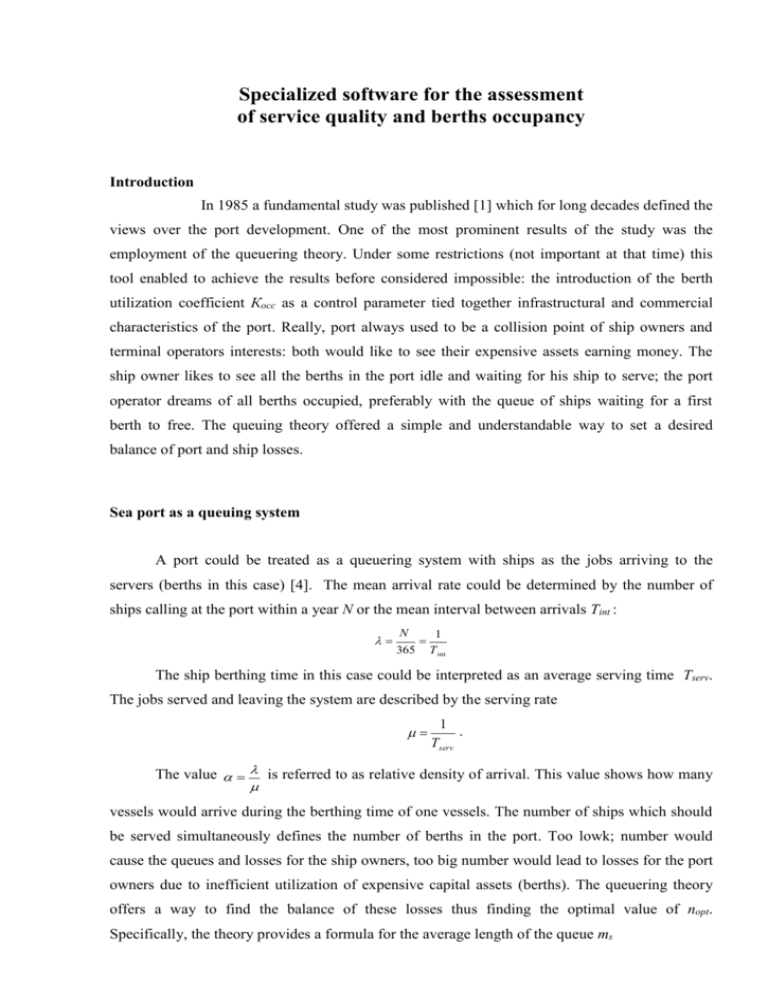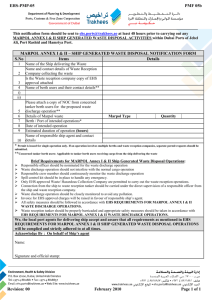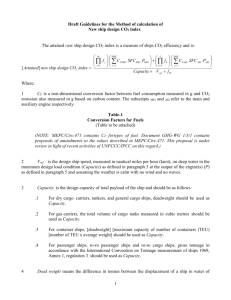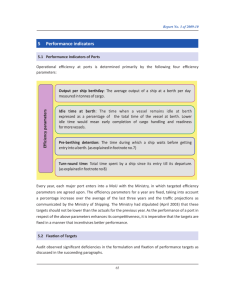The description of general model
advertisement

Specialized software for the assessment of service quality and berths occupancy Introduction In 1985 a fundamental study was published [1] which for long decades defined the views over the port development. One of the most prominent results of the study was the employment of the queuering theory. Under some restrictions (not important at that time) this tool enabled to achieve the results before considered impossible: the introduction of the berth utilization coefficient Кocc as a control parameter tied together infrastructural and commercial characteristics of the port. Really, port always used to be a collision point of ship owners and terminal operators interests: both would like to see their expensive assets earning money. The ship owner likes to see all the berths in the port idle and waiting for his ship to serve; the port operator dreams of all berths occupied, preferably with the queue of ships waiting for a first berth to free. The queuing theory offered a simple and understandable way to set a desired balance of port and ship losses. Sea port as a queuing system A port could be treated as a queuering system with ships as the jobs arriving to the servers (berths in this case) [4]. The mean arrival rate could be determined by the number of ships calling at the port within a year N or the mean interval between arrivals Тint : N 365 1 Т int The ship berthing time in this case could be interpreted as an average serving time Тserv. The jobs served and leaving the system are described by the serving rate 1 Tserv . The value is referred to as relative density of arrival. This value shows how many vessels would arrive during the berthing time of one vessels. The number of ships which should be served simultaneously defines the number of berths in the port. Too lowk; number would cause the queues and losses for the ship owners, too big number would lead to losses for the port owners due to inefficient utilization of expensive capital assets (berths). The queuering theory offers a way to find the balance of these losses thus finding the optimal value of nopt. Specifically, the theory provides a formula for the average length of the queue ms This formula includes as variables the number of servers n and the relative density . Since Кocc= /n, for practical purposes it is more illustrative to express ms as a function of Кocc. This dependence was presented in [1] as a table, without sufficient explanations and with references to special literature sources. The missing link in reasoning put certain obstacles in development of advance perception and heuristic enhancement of the proposed approach. As an additional unpleasant consequence the fact should be mentioned that Кocc started to be generally treated as a design parameter, while the nature of this value makes it just an intermediate one. It is more logical to set the dependence of two main values vitally important for ship owners and port operators – average waiting ratio and utilization of berths – as functions of the annual cargo turnover Q and number of berth n in the port. The dependence of Кocc from Q at given berth number n in this case is trivial: Кocc=(N*Тserv)/(n*365)=(Q*Тserv)/(n*365*V), where V is the ship capacity. In more complicated cases to be studied below, this dependence will be not as simple. If we denote the berth productivity as P=V/Тserv, then in order to handle the annual cargo turnover Q the time Twork=Q/P would needed. Since the time budget of n berths is n*365, eventually we have Кзан=Q/(P*n*365)/ Thus we formed a gueuering system model with a new structure (Figure 1). Figure 1 – New structure of the gueuering model The restrictions of the queuering models Today, with new vessel size range, route rationalization and port infrastructure design, nearly all main assumptions to the ship arrival discipline are not observed. The arrival flow is never stationary due to commercial circumstances, some ships arrive randomly, some obey the schedules etc. Still, the most important is totally different interpretation needed for the berths as servers. Historically, a berth as construction entity was equal to administrative (management) unit. Since the ship’s sizes were close to the berth length, this fact did not cause any problem. The constant growth of the ship and berth sizes caused problems in interpretation of berth occupancy, since in some cases several ships could be served at one berth and in other cases one ship could occupy more than one berth. The definition of Кocc in this case could corrected Кocc =( Σ l shipi.tshipi ) / L.Тб , but anyway it would ruin the basic assumption enabling to use the queuering theory. The description of general model Let us assume that we would like to estimate the maximal cargo turnover Q during an interval Т realized with the ships with different capacity, whose inputs in Q are defined by the probability distribution P(V). An example of this distribution is given by Figure 2. Figure 2 – Histogram of ship capacity distribution This distribution gives probabilities pi of appearance among all N ships during the interval T the ships of capacity vi , i.e. Thus we have That enables us to calculate the average number of calls of the ships of different capacity: For every ship type we can assess the average arrival interval τi = T/ni . Let us also assume that the stochastic value of every ship type arrival fluctuates around this mean interval. If we assume a low of the fluctuation, possibly different for every type, we could generate a partial arrival flows for every ship type (Figure 3). Figure 3 – Partial arrival flows of different ship types Let us further assume that we have several different berths, Bk, k=1,…,K , whose characteristics (permitted ship length and draft, cargo handling equipment, commercial terms of the contracts with shipping lines etc.) permit to accepts not all ships at every berth, while different productivity establish different turnaround time at different berths. In a general case the equipment could build a common pool to be distributed by some specific lows among singl berths in the group. Let us introduce a matrix [tik] IxK , whose element tik shows, at what time a ship of capacity vi is handled at the bert Bk. If tik=0, the ship cannot be accommodated at this particular berth (see Figure 4). Figure 4– Matrix of serving time at different berths The genera structure of the model dealing with the above mentioned assumptions is illustrated by Figure 5. Figure 5 - The structure of the proposed model The proposed model enables us to undertake the study of main parameters – occupation of different berths and waiting ratio for different ship types – as function of cargo turnover Q. Every single model’s run at fixed external parameters involves the changing of possible cargo turnover from zero to a given value (or a value showing unlimited waiting ratio growth at least for one berth). Implementation of the model The full-scaled imitation model implementing the described approach is realized on a very sophisticated and licensed object-oriented platform. For many applications, for example for technological design of ports and terminals, when the number of berths and number of STS is under optimization, there would be enough to use a simplified versions, since the use of the advanced software would be connected with the barrier of learning. For this purposes a MS EXCEL version of the model was developed, where the common spreadsheets are used as a common or easily studying interface. The sophisticated software “engine” is hidden “under the hood” of this product, looking very simple and innocent. The data are keyed in the tables shown on figures 6-8. Description Total length of the quaywall Cargo turnover for interval of simulation STS productivity unit Denotation Value [m] L Q P0 3 840 12 000 000 25 1,75 0,90 0,10 0,80 8 760 [teu/interval] [moves/hour] TEU-factor Ship capacity utilization Mooring interval as share of LOA Decrease of Р from the number of STS Simulation interval [teu/box] K teu K ship K moor K STS [hours] T Annual cargo turnover for an experiment Seria of experiments Annual cargo turnover [teu/year] Q year 12 000 000 End Step No of steps 6 000 000 12 000 000 1 000 000 6 Begin Figure 6 - General data on the project Vessel types Vessel capacity v1 1000 v2 2000 v3 3000 v4 4000 v5 5000 v6 6000 v7 7000 v8 8000 v9 9000 v10 10000 Im vi 900 1800 2700 3600 4500 5400 6300 7200 8100 9000 Ex vi 900 1800 2700 3600 4500 5400 6300 7200 8100 9000 Share in the cargo turnover αi 0,05 0,05 0,075 0,15 0,2 0,15 0,15 0,075 0,05 0,05 Number of ship calls Ni 306 153 153 229 244 153 131 57 34 31 Optimal allocation of STS per ship ni 2 2 3 3 4 4 5 5 6 6 [m] li 200 210 250 280 300 350 400 400 400 400 Delays [hour] τi Ship operation time [hour] ti discharge time [hour] Im ti 11,4 22,9 23,7 31,6 30,3 36,3 34,3 39,2 37,0 charge time [hour] Ex ti 11,4 22,9 23,7 31,6 30,3 36,3 34,3 39,2 37,0 [hour] Ti [teu] vi Import party [teu] Export party [teu] Length of the ship (LOA) Ship berth time Interval distribution low Parameter 1 Parameter 2 Average interval 1 22,9 23,9 Erlang code [hour] 1 45,7 2 47,5 46,7 Erlang 2 63,3 49,5 Erlang 2 2 60,5 65,3 Erlang 3 72,6 62,5 Erlang 68,6 74,6 Erlang 3 3 78,4 71,6 Erlang 74,1 81,4 Erlang 3 82,3 77,1 Erlang 41,1 41,1 85,3 Erlang 2 2 3 3 4 4 5 5 5 5 29 57 57 38 36 57 67 153 258 287 Figure 7- Ships description Ships STS per ship Berths B1 B2 B3 B4 B5 B6 B7 B8 B9 B10 v1 2 1 1 1 1 v2 2 1 1 1 1 v3 3 1 1 1 1 v4 3 1 1 1 1 1 1 v5 4 1 1 1 1 1 1 v6 4 1 1 1 1 1 1 v7 5 1 1 1 1 v8 5 1 1 1 1 v9 6 1 1 1 1 v10 6 1 1 1 1 Berth length No of STS [м] 280 280 380 380 380 380 440 440 440 440 [шт] 2 2 3 3 4 4 5 5 6 6 L/T utilization STS utilization Occupancy Figure 8- Berths description and ship/berth compatibility Figures 9-10 display the screenshots of the model’s serial run over some interval where the cargo turnover reaches maximally accepted values for a given ship capacity distribution and specified berth’s characteristics. Figure 9 – Screenshot for the waiting ratio as a function of the cargo turnover Figure 10 – Screenshot for berth occupancy as a function of the cargo turnover Brief operational manual The first spreadsheet named Terms of Reference (ToR) is designated for input of general information about the port study project. This window offers to key in main parameters of the project under study: STS hour productivity, TEU-factor, ship capacity utilization, increase of the space occupied by the ship at berth caused by mooring, decrease of the STS productivity due to interference of operations and the simulation interval (Fig.11). Figure 11 – ToR spreadsheet The string “Annual cargo turnover” sets the variation range of the main project variable, i.e. the terminal throughput (the beginning value, the end value, the step of increase). The general rule here and later on this description is that all values which should and could be set are highlighted by red font, while the calculated interim and resulting values are colored black . Next spreadsheet is named SHIPS and enables to input information about the vessels calling at the port under study (Fig.12). Figure 12 – SHIPS spreadsheet Here one can define vessel type names (ten different types in the trial version denoted v1v10), their capacities, shares of import and export parties (implicitly set by capacity utilization set by ToR, Fig.11), vessel shares (vessel inputs) in the total cargo turnover, required (desired) number of STS to handle, LOA, average operational delays at berth. The distribution of the intervals between the ship arrivals in this trial version is supposed to be governed by Erlang laws, and the order of the Erlang low could be set different for different vessels. (Erlang 0 is pure random Poisson distribution, with the growth of the order it starts to be more and more close to regular intervals). Graphics on the right side of Fig.12 illustrate the given distribution by vessel percentage in the cargo turnover and calculated mean values of the arrival intervals. The spreadsheet named BERTHS is provided to describe the berths characteristics, specifically their length and available number of cranes (which could differ from required for a ship), as well as compatibility of ships and berths (Fig.13). Figure 13– BERTHS spreadsheet The symbol “1” in the crossing of a column i and string j means that the vessel Vi could be accepted by the berth Bj. At different berths the same ship could be handled in different time defined by the number of STS available at this berth. That’s why some berth are preferable for a particular ship, while the others available should be selected only when all optimal berths are already occupied. After all these data are keyed in, one could run the simulation. In order to do so, one should select the most right button at the upper bar in any spreadsheet (“superstructure”, Fig14). Figure 14 – The control of the simulation run Here one can set the number of model run iterations to be performed at every step of the cargo throughput increase from the beginning to the end, select the berth optimization algorithm (first available of optimal ones or the most idle of optimal), switch on or off the initial warm-up period to bring the process on the stable level. The button “calculate” run the experiment series. The spreadsheet WAIT RATIOO displays the dynamics of the queue’s length during the simulation run, as is shown by Fig.15. Figure 15 –WAIT RATIO spreadsheet Figure 16 – OCCUPANCE SERIES spreadsheet The course of the simulation is displayed by a special indicator as shown on the Fig.17. Figure 17 – Progress indicator Conclusions 1. The approach is described which could be treated as a logical extension of the queuering theory for modern berths and cargo handling equipment in port design procedures. 2. The adequacy of the approach is proven by the comparison with the queuering theory results when applicable. 3. The approach is implemented both in a highly specific product (built in the full-scale simulation model used for the task of global resource optimization software under development) and a stand-alone version using MS EXCEL as a friendly interface. 4. The MS EXCEL version proved to be useful and efficient at the stage of port and terminal design for the optimization of berth number and STS fleet justification. 5. The product could be recommended for any persons engaged in the optimization of the number of berths, berth productivity, number of cranes on the berths, the influence on the port capacity of the different ship calls distribution. 6. Especially usefully this instrument could be when design and planning of port operations for non-interchangeable berths. 7. Any interested specialists could apply for an advanced simulation tools with much wide scope and enhanced research features. Literature 1. Port development. A handbook for planners in developing countries. United Nations, UNCTAD, New York, 1985






